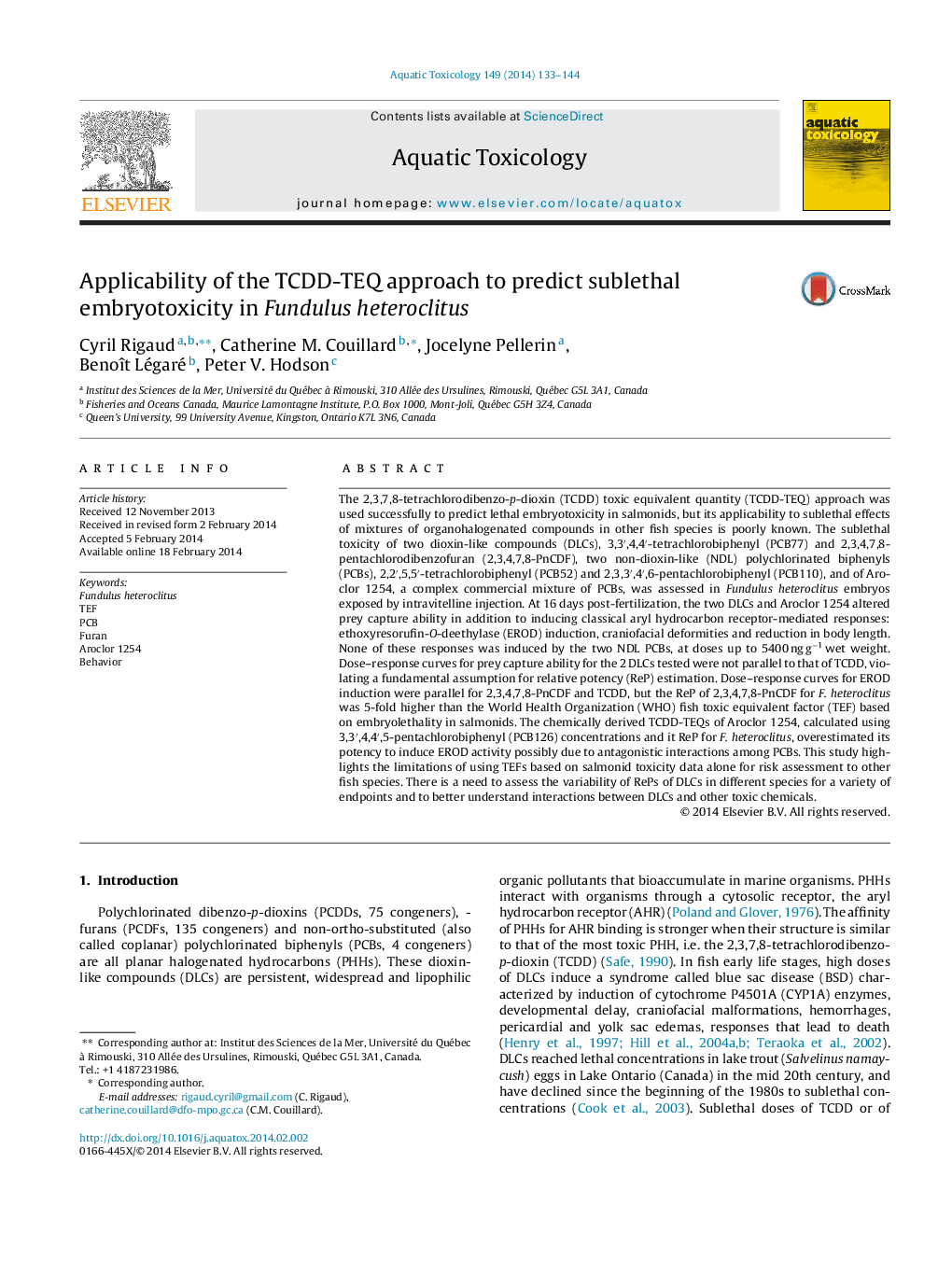| کد مقاله | کد نشریه | سال انتشار | مقاله انگلیسی | نسخه تمام متن |
|---|---|---|---|---|
| 6382472 | 1625956 | 2014 | 12 صفحه PDF | دانلود رایگان |
عنوان انگلیسی مقاله ISI
Applicability of the TCDD-TEQ approach to predict sublethal embryotoxicity in Fundulus heteroclitus
دانلود مقاله + سفارش ترجمه
دانلود مقاله ISI انگلیسی
رایگان برای ایرانیان
کلمات کلیدی
موضوعات مرتبط
علوم زیستی و بیوفناوری
علوم کشاورزی و بیولوژیک
علوم آبزیان
پیش نمایش صفحه اول مقاله

چکیده انگلیسی
The 2,3,7,8-tetrachlorodibenzo-p-dioxin (TCDD) toxic equivalent quantity (TCDD-TEQ) approach was used successfully to predict lethal embryotoxicity in salmonids, but its applicability to sublethal effects of mixtures of organohalogenated compounds in other fish species is poorly known. The sublethal toxicity of two dioxin-like compounds (DLCs), 3,3â²,4,4â²-tetrachlorobiphenyl (PCB77) and 2,3,4,7,8-pentachlorodibenzofuran (2,3,4,7,8-PnCDF), two non-dioxin-like (NDL) polychlorinated biphenyls (PCBs), 2,2â²,5,5â²-tetrachlorobiphenyl (PCB52) and 2,3,3â²,4â²,6-pentachlorobiphenyl (PCB110), and of Aroclor 1254, a complex commercial mixture of PCBs, was assessed in Fundulus heteroclitus embryos exposed by intravitelline injection. At 16 days post-fertilization, the two DLCs and Aroclor 1254 altered prey capture ability in addition to inducing classical aryl hydrocarbon receptor-mediated responses: ethoxyresorufin-O-deethylase (EROD) induction, craniofacial deformities and reduction in body length. None of these responses was induced by the two NDL PCBs, at doses up to 5400 ng gâ1 wet weight. Dose-response curves for prey capture ability for the 2 DLCs tested were not parallel to that of TCDD, violating a fundamental assumption for relative potency (ReP) estimation. Dose-response curves for EROD induction were parallel for 2,3,4,7,8-PnCDF and TCDD, but the ReP of 2,3,4,7,8-PnCDF for F. heteroclitus was 5-fold higher than the World Health Organization (WHO) fish toxic equivalent factor (TEF) based on embryolethality in salmonids. The chemically derived TCDD-TEQs of Aroclor 1254, calculated using 3,3â²,4,4â²,5-pentachlorobiphenyl (PCB126) concentrations and it ReP for F. heteroclitus, overestimated its potency to induce EROD activity possibly due to antagonistic interactions among PCBs. This study highlights the limitations of using TEFs based on salmonid toxicity data alone for risk assessment to other fish species. There is a need to assess the variability of RePs of DLCs in different species for a variety of endpoints and to better understand interactions between DLCs and other toxic chemicals.
ناشر
Database: Elsevier - ScienceDirect (ساینس دایرکت)
Journal: Aquatic Toxicology - Volume 149, April 2014, Pages 133-144
Journal: Aquatic Toxicology - Volume 149, April 2014, Pages 133-144
نویسندگان
Cyril Rigaud, Catherine M. Couillard, Jocelyne Pellerin, Benoît Légaré, Peter V. Hodson,